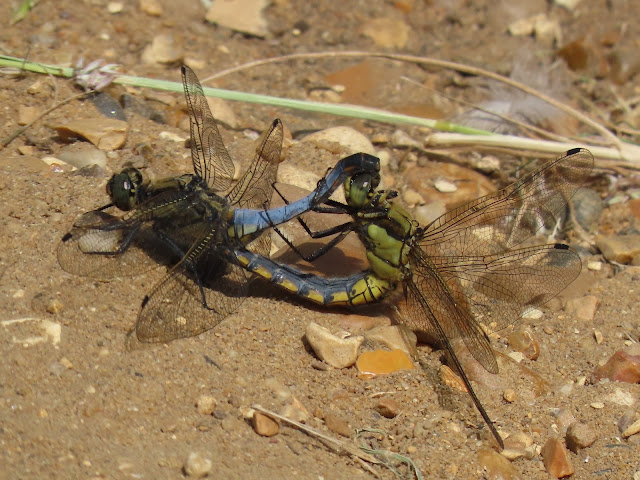Sunday 26th
After breakfast we took a different Landrover into the
forest but this one conked out so we had to send for yet another one. New birds
for the trip included Dusky Long-tailed Cuckoo, Grey Parrot, Forest Robin,
White-tailed Alethe, Chocolate-backed Kingfisher and Fraser’s Forest
Flycatcher.
 |
| Chocolate-backed Kingfisher |
 |
| Pale-breasted Illadopsis |
We returned to the lodge late morning and then packed up and
reloaded the Landrover for the return trip along the approach road. We decanted
back into our minibus and drove to a Brenu Grassland.
The change of habitat gave us a different selection of birds
including a pair of duetting Tropical Boubou, Black-crowned Tchagra and a variety of weavers and
sunbirds. We continued onto the Rainforest Lodge back in Jukwa.
 |
| Black-crowned Tchagra |
 |
| Tropical Boubou |
Monday 27th
After checking out of
the hotel we made our way to an area of scrub and grasslands along the
Jukwa Krobo Road. Here we found Blue-headed Coucal, Marsh and Brown-crowned
Tchagras, Yellow-mantled Widowbird, Mottled Spinetail, more Rosy Bee-eaters and
plenty of other birds before we had to leave for the long drive to our next
site.
 |
| Guinea Turaco |
 |
| Marsh Tchagra |
 |
| Simple Greenbul (the name has nothing to do with its cognitive abilities!) |
 |
| Common Fiscal, regularly seen whilst driving |
We arrived mid-afternoon and checked into a new
community-based lodge at Bonkro next to the Forest. This accommodation meant we
didn’t have to walk far to the site. Next to a large boulder some benches had
been built so we made ourselves comfortable and waited for the event.
After 45
minutes, the first White-necked Picathartes was seen. It bounded along in front
of us in a series of jumps and perched up in a nearby tree. Just as it vanished
we got a message from one of the local villagers that had accompanied us along
the walk that they had found a Pangolin!
We were torn by wanting to go and see
it and waiting for more Picathartes but after a minute we decided to go. It was
only a minute away and we were soon watching one of these rare spiny mammals
sleeping up a tree. We then realised we’d stepped onto a swarm of ants and had
to rapidly leave the area and de-ant before we could resume our vigil on the
benches.
 |
| Long-tailed Pangolin |
A little while later another Picathartes came in and perched
up and was soon followed by three more of these strange looking birds. They are
a very unique family of birds that have no obvious looking close relatives.
Over the next two hours we watched them bounce around the rocks and up into the
trees, preening before eventually making their way to their nests to roost for
the night. Fully sated, we made our way down the track as darkness fell.
.JPG) |
| White-necked Picathartes |
After dinner we walked back to our cabins across the lawn
and straight into another load of ants who took a particular liking to Lynne. A
major de-anting session was required before it was safe to retire for the
night.
Tuesday 28th
Today was mostly a driving day as we headed up north to Mole
National Park. The journey took 12 hours as we moved out of the humid forests
of the south and into the dry Sahel region. In the afternoon we did manage to
see quite a few species at one short stop at Janikura Marshes. Raptors such as
Booted Eagle, Grasshopper Buzzard and Lanner began to appear and the default
pigeon became Vinaceous Dove with its ‘tomahawk-tomahawk’ call.
 |
| Grasshopper Buzzard |
 |
| Spur-winged Lapwing |
 |
| Vinaceous Dove |
We checked into the Mole Motel which is on the edge of an
escarpment looking down over the park. Just outside our rooms we could see down to the waterhole below.
 |
| waterhole at Mole |

























.JPG)




























.JPG)
.JPG)







